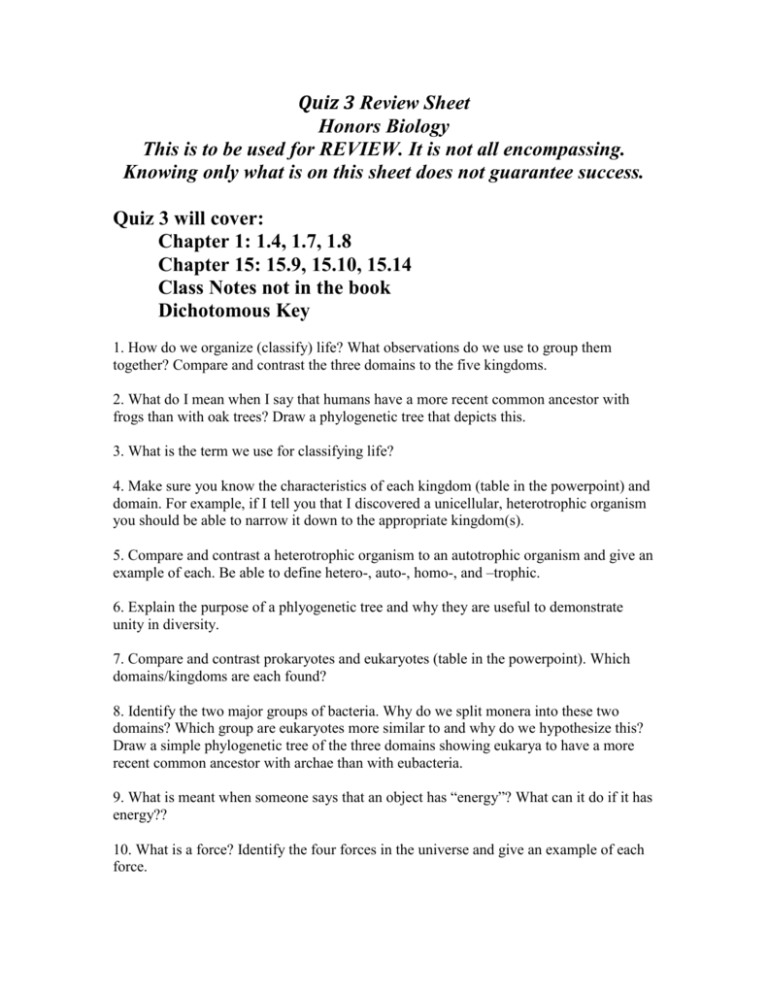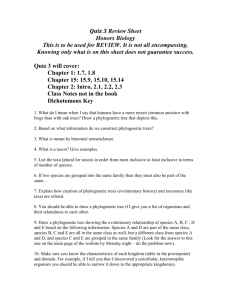Quiz 3 Review Sheet 9/28/10
advertisement

Quiz 3 Review Sheet Honors Biology This is to be used for REVIEW. It is not all encompassing. Knowing only what is on this sheet does not guarantee success. Quiz 3 will cover: Chapter 1: 1.4, 1.7, 1.8 Chapter 15: 15.9, 15.10, 15.14 Class Notes not in the book Dichotomous Key 1. How do we organize (classify) life? What observations do we use to group them together? Compare and contrast the three domains to the five kingdoms. 2. What do I mean when I say that humans have a more recent common ancestor with frogs than with oak trees? Draw a phylogenetic tree that depicts this. 3. What is the term we use for classifying life? 4. Make sure you know the characteristics of each kingdom (table in the powerpoint) and domain. For example, if I tell you that I discovered a unicellular, heterotrophic organism you should be able to narrow it down to the appropriate kingdom(s). 5. Compare and contrast a heterotrophic organism to an autotrophic organism and give an example of each. Be able to define hetero-, auto-, homo-, and –trophic. 6. Explain the purpose of a phlyogenetic tree and why they are useful to demonstrate unity in diversity. 7. Compare and contrast prokaryotes and eukaryotes (table in the powerpoint). Which domains/kingdoms are each found? 8. Identify the two major groups of bacteria. Why do we split monera into these two domains? Which group are eukaryotes more similar to and why do we hypothesize this? Draw a simple phylogenetic tree of the three domains showing eukarya to have a more recent common ancestor with archae than with eubacteria. 9. What is meant when someone says that an object has “energy”? What can it do if it has energy?? 10. What is a force? Identify the four forces in the universe and give an example of each force. 11. How does a force relate to energy? Think about a bowling ball on a table. It has energy. Why? What force gives it energy? 12. Explain why scientists changed the five kingdom system to the 3 domain system via the 6 kingdom system. 13. What do I mean when I say that humans have a more recent common ancestor with frogs than with oak trees? Draw a phylogenetic tree that depicts these two organisms plus elm trees. 14. Based on what information do we construct phylogenetic trees? 15. What is a taxon (look this up – you know what it is)? Give examples. 16. List the taxa (plural for taxon) in order from most inclusive to least inclusive in terms of number of species. 17. If two species are grouped into the same family then they must also be part of the same… 18. Explain how the creation of phylogenetic trees (evolutionary history) and taxonomy/classification of organisms (the taxa) are related. 19. You should be able to draw a phylogenetic tree if I give you a list of organisms and their relatedness to each other. 20. Draw a phylogenetic tree showing the evolutionary relationship of species A, B, C , D and E based on the following information. Species A and D are part of the same class, species B, C and E are all in the same class as well, but a different class from species A and D, and species C and E are grouped in the same family (Look for the answer to this one on the main page of the website by Monday night – do the problem now). 21. Make sure you know the characteristics of each kingdom (table in the powerpoint) and domain. For example, if I tell you that I discovered a unicellular, heterotrophic organism you should be able to narrow it down to the appropriate kingdom(s). 22. Compare and contrast a heterotrophic organism to an autotrophic organism and give an example of each. Be able to define hetero-, auto-, homo-, and –trophic. 23. You should be able to identify an organism’s genus and species using a dichotomous key as well as write a simple dichotomous key to identify a number of species similar to the lab. 24. Be able to explain in detail Figure 1.7A in terms of energy flow and cycling of chemical nutrients (food web). 25. Explain why we said that energy flows (one-way). Describe, starting from the sun, the flow of energy to Earth and away from Earth. 26. In class we briefly spoke about global warming and it being caused by the greenhouse effect. Explain how the greenhouse effect works and identify whether this effect is positive or negative to our existence on this planet. 27. Describe what is meant when we say that chemical nutrients cycle between the abiotic and the biotic. Give specific examples of nutrients cycling. You will be asked to describe how an atom somewhere could end up somewhere else as we did in class (i.e. a carbon in me could find itself being part of your great, great grandkids a hundred years from now). 28. Explain the role of decomposers in an ecosystem using figure 1.7A. 29. Explain what is means when someone says the we are just “star dust”.







